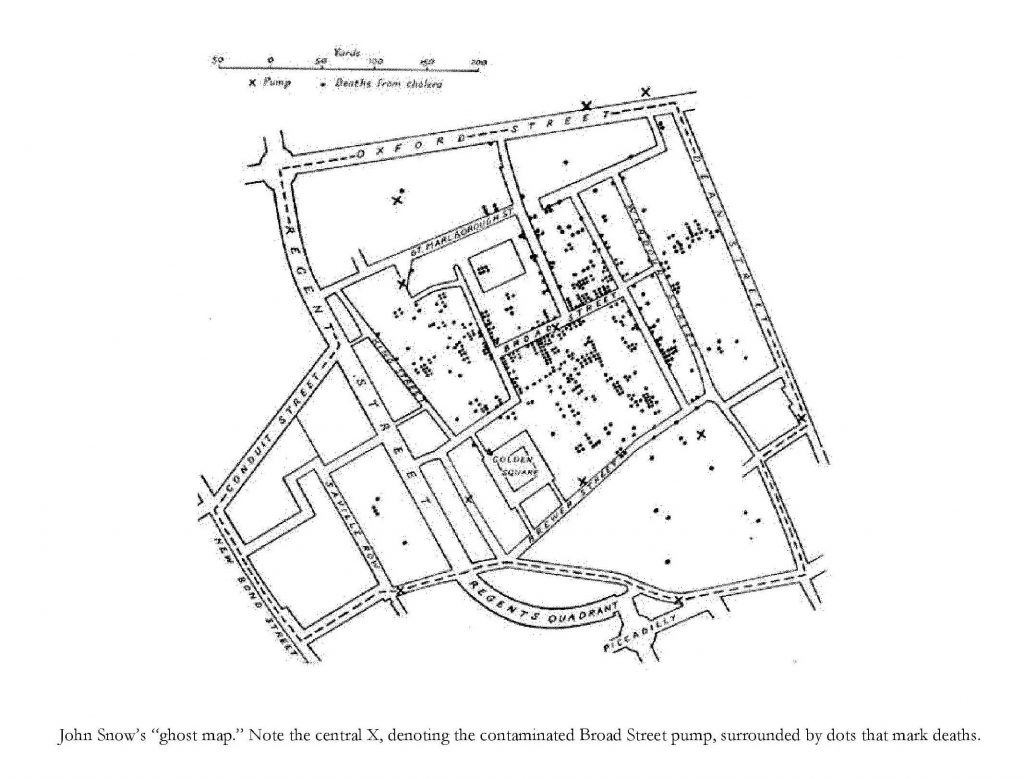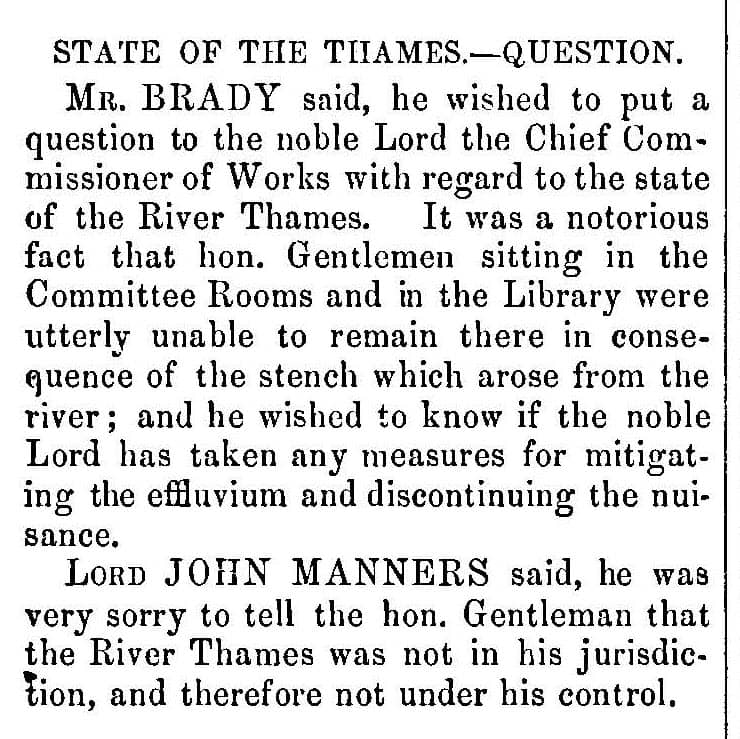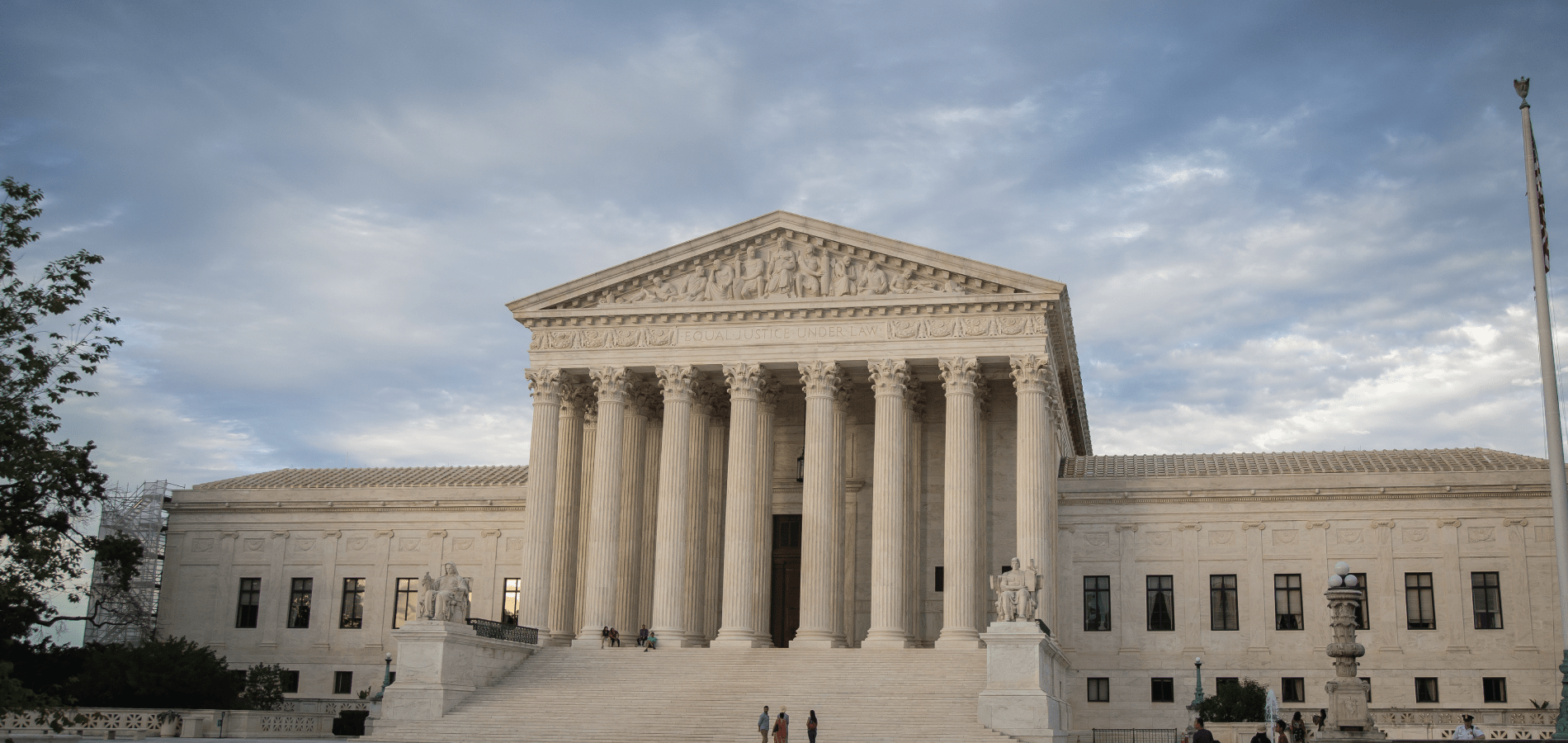Summer has officially begun in the Northern Hemisphere, bringing with it the sweet smells of fresh cut grass and flowering crape myrtles, the savory aroma of grilling hot dogs and hamburgers, and the unmistakable waft of sunscreen and chlorine while lounging at the pool.
But our summers weren’t always so sanitized. Today on the HeinOnline Blog, we’re going to turn back the clock to the summer of 1858 and travel to London, where citizens suffered through a very disgusting, very smelly summer that, almost 170 years later, is still ominously remembered as the Great Stink.
Did you know? While the HeinOnline Blog doesn’t have smell-o-vision (thankfully!), it does have an audio option. So if you prefer to listen rather than read, hit the headphone icon to hear this post.
The Great Stink of Cholera
By the dawn of the 19th century, London’s population had outgrown the existing sewer system’s capacity, which had served the metropolis since the 1600s. Open drains and cesspits overflowed with fetid refuse from humans and animals.
These open drains were a serious public health hazard. Cholera was rampant. Cholera is a bacterial disease spread through fecal-contaminated food or water. It causes severe diarrhea and dehydration and is fatal if not treated. While the modern industrialized world has largely forgotten cholera, the disease still kills between 21,000–143,000 people every year.
While today we know that cholera is caused by bacteria, before humans accepted germ theory it was thought that most diseases, including cholera, were caused by “miasma,”[1]Marc Trabsky, Institutionalising the Public Abattoir in Nineteenth Century Colonial Society, 40 AUSTL. FEMINIST L.J. 169 (2014). This article is found in HeinOnline’s Law Journal Library. noxious and offensive odors. As such, efforts to curb the rampant spread of cholera were aimed at stamping out the stinky smells that were harbingers of disease.
In 1848, Parliament established the Metropolitan Commission of Sewers,[2]Statutes of the United Kingdom of Great Britain and Ireland with Notes, References and an Index (1847-1849). This law is found in HeinOnline’s Selden Society Publications. which consolidated existing separate commissions into one body responsible for the greater London area. It was supposed to cover over and outlaw cesspits[3]Frederick Clifford. History of Private Bill Legislation (1887). This book is found in HeinOnline’s Legal Classics.—open pits under houses that collected sewage— and connect households to a main sewer.
John Snow Sniffs Out the Broad Street Pump
The Metropolitan Commission of Sewers set about ridding London of hundreds of thousands of open cesspits[4]Hugh Pattison Macmillan. Local Government Law and Administration in England and Wales (1937). This book is found in HeinOnline’s Legal Classics. by closing them up and rerouting sewers to discharge into the River Thames. Not only was the Thames the discharge point for the city’s sewers, it also received every unmentionable fetid castoff from the slaughterhouses and factories that lined her banks. Even as the river was used to ingest every disgusting byproduct of city life imaginable, the same putrid water was pumped back out for citizens to cook with, wash in, and drink.
Summer, 1854: The Smell of Death
The end of summer in 1854 saw a terrible outbreak of cholera in London’s Soho neighborhood. Between September 1 and September 10, 500 people died of cholera.[5]Alan Kerwick, The Soho Epidemic of Cholera, 33 MEDICO-LEGAL J. 152 (1965). This article is found in HeinOnline’s Law Journal Library. John Snow was a highly respected physician who in 1853 had been personally chosen to administer chloroform to Queen Victoria[6]James Salzman, Is It Safe to Drink the Water?, 19 DUKE ENVTL. L. & POL’y F. 1 (2008). This article is found in HeinOnline’s Law Journal Library. when she gave birth to Prince Leopold. Snow was skeptical of the miasma theory of disease, and with a critical eye he studied the outbreak. He plotted the cholera cases on a city map and went door-to-door through the cholera-ravaged neighborhood, asking the residents who supplied their water.
Snow discovered that households supplied by the Southwark and Vauxhall water company had a cholera rate 8.5x higher than their neighbors.[7]Rhett B. Larson, Law in the Time of Cholera, 92 NOTRE DAME L. REV. 1271 (2017). This article is found in HeinOnline’s Law Journal Library. The Southwark and Vauxhall water company supplied their customers with unfiltered and untreated water that was drawn from the Thames downstream from major sewer discharges. But no households had higher cholera deaths than those who used one specific water pump on Broad Street.
Snow’s suspicion that tainted water from the pump was causing the cholera outbreak, not smelly air, was confirmed by the case of Susannah Eley.[8]James Salzman, Is It Safe to Drink the Water?, 19 DUKE ENVTL. L. & POL’y F. 1 (2008). This article is found in HeinOnline’s Law Journal Library. Eley was a widow who lived in Hampstead, far from Soho, but had died of cholera. When Snow interviewed her son, he learned that Eley had used to live in Soho and enjoyed the taste of water from the Broad Street pump so much that she regularly had her sons bring her water from it. When Snow investigated the pump, it was discovered that a baby living in a house next door to the pump had died of cholera two days before the outbreak started.[9]Alan Kerwick, The Soho Epidemic of Cholera, 33 MEDICO-LEGAL J. 152 (1965). This article is found in HeinOnline’s Law Journal Library. Waste water from washing the child’s infected diapers had drained into a cesspit under the house. The cesspit was leeching into the public well that fed the Broad Street pump. To stop further outbreaks, Snow removed the handle from the pump.[10]Robert Griffin, Tracking Environmental Diseases with Epidemiology, 13 EPA J. 26 (1987). This article is found in HeinOnline’s Law Journal Library.

Today, John Snow’s plotting of cholera cases around the Broad Streep pump is considered the genesis of epidemiology. But when his findings were published in 1855, they were soundly rejected and Snow was, bizarrely, accused of being “an enemy of sanitary reform”[11]Lewis C. Vollmar Jr., The Effect of Epidemics on the Development of English Law from the Black Death through the Industrial Revolution, 15 J. LEGAL MED. 385 (1994). This article is found in HeinOnline’s Law Journal Library. for rejecting miasma theory.
The Great Stink
Even though officially John Snow’s conclusion that cholera was caused by drinking fecal-contaminated water had been rejected, cholera remained a public health enemy. London continued to try and rid the city of cholera-causing smells. The “solution” continued to be to empty sewers into the Thames.
Almost since its inception,[12]Frederick Clifford. History of Private Bill Legislation (1887). This book is found in HeinOnline’s Legal Classics. various proposals had been made to the Metropolitan Commission of Sewers and its successor, the Metropolitan Board of Works, to build new sewers and pumping stations. They were all rejected for being too costly.
But four years after the Soho cholera outbreak, London’s sewer struggles were becoming unignorable from an olfactory point of view. The flushable toilet had been invented[13]Andrew P. Lugger, From Bog Man to Crapper – Andrew Lugger Explores the History of Public Sanitation in Victorian England, 43 B. L. J. 72 (2011). This article is found in HeinOnline’s Law Journal Library. and subsequently increased the amount of wastewater being emptied directly into the Thames. The city’s sanitation work had transformed the Thames itself into one giant cesspit.
Summer, 1858: Sewage Is in the Air
In the summer of 1858, London sweltered under an oppressive, record-breaking heatwave, which baked the putrid river and intensified its already horrible stench. As summer blazed on, the Thames’ water level dropped, exposing liquid sewage caked into the river’s banks. Rich or poor, noble or common, no one was immune from the great stink.
Even Parliament, sitting next to the polluted river, wasn’t shielded from the stinky suffering. The first whiff of how bad the situation had become came on June 4th, when MP Griffith asked Lord John Manners, Chief Commissioner of Works, about “the effect upon the purity of the air which may be produced by the liberation of gases injurious to health from the water.”[14]150 HC Deb 738 (1858). This debate can be found in HeinOnline’s UK Parliamentary & Government Publications (Public Information Online). Nothing was done. On June 11, MP James Brady rose to again question Lord John Manners about the smell, which made sitting in the committee rooms and library impossible, asking if “any measure for mitigating the effluvium and discontinuing the nuisance”[15]150 HC Deb 738 (1858). This debate can be found in HeinOnline’s UK Parliamentary & Government Publications (Public Information Online). had been made. In response, Lord John Manners informed him that the River Thames was not in his jurisdiction.

On June 15, Lord John Manners was once again grilled about the river’s state, this time by MP Ross Mangles, eliciting laughter from some of his fellow MPs. “My question, I perceive, excites the laughter of some hon.(orable) Gentlemen,” Mangles said, “but I can assure them that if they lived in the vicinity of the Thames they would not think my question one of little importance.”[16]150 HC Deb 738 (1858). This debate can be found in HeinOnline’s UK Parliamentary & Government Publications (Public Information Online). He went on to describe the situation as one where “by a perverse ingenuity, one of the noblest of rivers has been changed into a cesspool.”[17]150 HC Deb 738 (1858). This debate can be found in HeinOnline’s UK Parliamentary & Government Publications (Public Information Online). Again, Lord Manners replied that “Her Majesty’s Government have nothing whatever to do with the state of Thames”[18]150 HC Deb 738 (1858). This debate can be found in HeinOnline’s UK Parliamentary & Government Publications (Public Information Online). and that the matter fell squarely to the Metropolitan Board of Works.

To help mitigate Parliament’s suffering, the building’s windows were covered in curtains soaked in chloride of lime.[19]Andrew P. Lugger, From Bog Man to Crapper – Andrew Lugger Explores the History of Public Sanitation in Victorian England, 43 B. L. J. 72 (2011). This article is found in HeinOnline’s Law Journal Library. It didn’t work. On June 25th, the Thames’ stinky state earned protracted debate in the House of Commons, after various attempts to better ventilate the chamber had failed.[20]151 HC Deb 144 (1858). This debate can be found in HeinOnline’s UK Parliamentary & Government Publications (Public Information Online). The Courts of Exchequer and Queen’s Bench had also been infected by the “pestiferous invader”[21]151 HC Deb 144 (1858). This debate can be found in HeinOnline’s UK Parliamentary & Government Publications (Public Information Online). and had been adjourned, unable to work through the great stink.
Bazalgette Freshens up the Great Stink
Working with a speed that was no doubt spurred to ameliorate their own suffering, on July 15th the House of Commons cleared its docket to hear the Metropolis Local Management Amendment Bill, which would write a check to the Metropolitan Board of Works for whatever it would cost to achieve “the purification of the river Thames.”[22]151 HC Deb 691 (1858). This debate can be found in HeinOnline’s UK Parliamentary & Government Publications (Public Information Online). Chancellor of the Exchequer (and future Prime Minister) Benjamin Disraeli[23]William Flavelle Moneypenny & George Earle Buckle. Life of Benjamin Disraeli, Earl of Beaconsfield (1910). This book is found in HeinOnline’s Spinelli’s Law Library Reference Shelf. prefaced his reading of the bill by commenting:[24] 151 HC Deb 691 (1858). This debate can be found in HeinOnline’s UK Parliamentary & Government Publications (Public Information Online).
“…several years back, when this House, in the pursuit of health, determined that the sewage of the metropolis should be diverted to the water of the Thames, there were some persons of great authority on such matters who foresaw the consequences of that measure. Sir, all that they then predicted has been more than fulfilled. That noble river, so long the pride and joy of Englishmen, which has hitherto been associated with the noblest feats of our commerce and the most beautiful passages of our poetry, has really become a Stygian pool, reeking with ineffable and intolerable horrors.”
The bill was passed on August 2nd.
The ultimate solution to the Thames’ woes had been floating around since 1856, when Joseph Bazalgette was elected Engineer to the Metropolitan Board of Works. At the time, Bazalgette proposed installing more than 1,000 miles of new street sewers. It was rejected then for being too costly. Now, repulsed by the smell of inaction, Bazalgette was given the funds to completely rebuild London’s sewers.
Bazalgette’s sewer system has been called “the most perfect, the most comprehensive, and at the same time the most difficult work of its class that has ever been executed.”[25]Thompson Cooper. Men of Mark: A Gallery of Contemporary Portraits of Men Distinguished in the Senate, the Church, in Science, Literature and Art, the Army, Navy, Law, Medicine, etc. (1877). This book is found in HeinOnline’s Spinelli’s … Continue reading Ornate and opulent pumping stations moved sewage down the Thames and out to sea. Bazalgette’s sewers took almost 20 years to complete and for his services to the city, Bazalgette was knighted in 1874. [26]Thompson Cooper. Men of Mark: A Gallery of Contemporary Portraits of Men Distinguished in the Senate, the Church, in Science, Literature and Art, the Army, Navy, Law, Medicine, etc. (1877). This book is found in HeinOnline’s Spinelli’s … Continue reading Bazalgette’s sewer system still services London today, although, in a callback to history, modern life has strained the system’s capabilities.[27]715 HC Deb 1037 (2022). This debate can be found in HeinOnline’s UK Parliamentary & Government Publications (Public Information Online).
Smell History with UK Parliamentary & Government Publications

This exploration of the Great Stink wafted across the internet with generous reliance on one of HeinOnline’s newest products, UK Parliamentary & Government Publications (Public Information Online), a partnership with Dandy Booksellers that brings millions of pages of key UK parliamentary materials into HeinOnline. This resource offers more than just a database; it’s a historical record, a research tool, and a legislative library all in one—and can be used to research just about anything that happened in British history, even great stinky summers. Curious what corners of history you could sniff out with this resource? Click the buttons below for more information.
HeinOnline Sources[+]
| ↑1 | Marc Trabsky, Institutionalising the Public Abattoir in Nineteenth Century Colonial Society, 40 AUSTL. FEMINIST L.J. 169 (2014). This article is found in HeinOnline’s Law Journal Library. |
|---|---|
| ↑2 | Statutes of the United Kingdom of Great Britain and Ireland with Notes, References and an Index (1847-1849). This law is found in HeinOnline’s Selden Society Publications. |
| ↑3 | Frederick Clifford. History of Private Bill Legislation (1887). This book is found in HeinOnline’s Legal Classics. |
| ↑4 | Hugh Pattison Macmillan. Local Government Law and Administration in England and Wales (1937). This book is found in HeinOnline’s Legal Classics. |
| ↑5, ↑9 | Alan Kerwick, The Soho Epidemic of Cholera, 33 MEDICO-LEGAL J. 152 (1965). This article is found in HeinOnline’s Law Journal Library. |
| ↑6, ↑8 | James Salzman, Is It Safe to Drink the Water?, 19 DUKE ENVTL. L. & POL’y F. 1 (2008). This article is found in HeinOnline’s Law Journal Library. |
| ↑7 | Rhett B. Larson, Law in the Time of Cholera, 92 NOTRE DAME L. REV. 1271 (2017). This article is found in HeinOnline’s Law Journal Library. |
| ↑10 | Robert Griffin, Tracking Environmental Diseases with Epidemiology, 13 EPA J. 26 (1987). This article is found in HeinOnline’s Law Journal Library. |
| ↑11 | Lewis C. Vollmar Jr., The Effect of Epidemics on the Development of English Law from the Black Death through the Industrial Revolution, 15 J. LEGAL MED. 385 (1994). This article is found in HeinOnline’s Law Journal Library. |
| ↑12 | Frederick Clifford. History of Private Bill Legislation (1887). This book is found in HeinOnline’s Legal Classics. |
| ↑13, ↑19 | Andrew P. Lugger, From Bog Man to Crapper – Andrew Lugger Explores the History of Public Sanitation in Victorian England, 43 B. L. J. 72 (2011). This article is found in HeinOnline’s Law Journal Library. |
| ↑14, ↑15 | 150 HC Deb 738 (1858). This debate can be found in HeinOnline’s UK Parliamentary & Government Publications (Public Information Online). |
| ↑16 | 150 HC Deb 738 (1858). This debate can be found in HeinOnline’s UK Parliamentary & Government Publications (Public Information Online). |
| ↑17, ↑18 | 150 HC Deb 738 (1858). This debate can be found in HeinOnline’s UK Parliamentary & Government Publications (Public Information Online). |
| ↑20, ↑21 | 151 HC Deb 144 (1858). This debate can be found in HeinOnline’s UK Parliamentary & Government Publications (Public Information Online). |
| ↑22 | 151 HC Deb 691 (1858). This debate can be found in HeinOnline’s UK Parliamentary & Government Publications (Public Information Online). |
| ↑23 | William Flavelle Moneypenny & George Earle Buckle. Life of Benjamin Disraeli, Earl of Beaconsfield (1910). This book is found in HeinOnline’s Spinelli’s Law Library Reference Shelf. |
| ↑24 | 151 HC Deb 691 (1858). This debate can be found in HeinOnline’s UK Parliamentary & Government Publications (Public Information Online). |
| ↑25, ↑26 | Thompson Cooper. Men of Mark: A Gallery of Contemporary Portraits of Men Distinguished in the Senate, the Church, in Science, Literature and Art, the Army, Navy, Law, Medicine, etc. (1877). This book is found in HeinOnline’s Spinelli’s Law Library Reference Shelf. |
| ↑27 | 715 HC Deb 1037 (2022). This debate can be found in HeinOnline’s UK Parliamentary & Government Publications (Public Information Online). |



